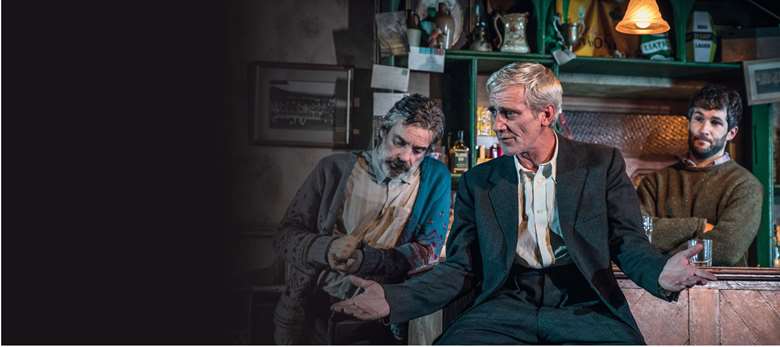Play for study: The Weir
Lucy Miller
Friday, May 1, 2020
Each issue of D&T we bring you a teacher's guide to a play for study with your students, written by a fellow teacher. This issue, Lucy Miller explores The Weir, a set text for Eduqas at A Level

MARC BRENNER
Conor McPherson's The Weir is one of the texts teachers can choose for the Eduqas A level Component 1: Theatre Workshop, a reinterpretation the text, inspired by a theatre practitioner or company. Teachers may also consider selecting the text for Component 2: Text in Action, where they perform an extract alongside a contrasting devised piece. But how does The Weir earn its place on this list of worthy recommended texts and is it worth considering?
The play
Originally performed at the Royal Court in 1997, McPherson's text still remains hauntingly poignant over two decades later, and enjoyed successful revivals in 2016 and 2018.
Set in an isolated Irish pub one evening, four local male residents gather for their usual pint or two. The difference tonight is the presence of a stranger, Valerie, who has recently relocated to the area. Initially the men regale her with local ghost stories, but it is ultimately Valerie's own true story of the loss of her daughter – which is also tinged with an element of the supernatural – that causes the evening to take on a very different tone.
In this seemingly simple play, McPherson draws on his childhood roots, growing up in Dublin, and the traditional Irish preoccupation with folklore. Yet, through these stories he uncovers something far more profound. Through his single location, convincing dialogue and naturalistic characters who are complex, fascinating and human, McPherson draws us into this compact world. In spite of the supernatural content, the most frightening discoveries of the evening are those of wasted opportunities, missed human connections and the vulnerability of the characters.
The hydroelectric dam of the title (also the name of the pub) features little, except perhaps to remind the audience of the negative impact of stifling human emotions. As the drink flows through the evening and the floodgates are eventually opened, we are left with a glimmer of hope for these characters, who are finally able to speak more simply and truthfully at the play's close.
Suggested approaches
When I chose the text for Component 1, I found that it was refreshing for students to study a play of truly powerful storytelling, without the ‘bells and whistles’ of dazzling multimedia effects so often experienced in contemporary theatre.
We began by telling stories. I invited students to share their own ghostly or supernatural experiences. In a darkened studio, with torches held up to our faces, I encouraged the students to consider what tradition McPherson is drawing on and what causes the characters to recount their tales to Valerie.
It might also be useful to consider structure carefully, early on. McPherson's structural sophistication in this play owes something to the traditions of Greek tragedy; with limited physical movement and use of reported action, most of the play's events take place in the past. It also conforms to the unities of time and place, unfolding in approximately 100 minutes in a single location. Its cleverly circular structure and traditional build to a climax and resolution are all worthy of examination.
If you choose the play for Component 2 it would suit careful study of relationships and subtext. The characters are often casually cruel to each other, but this is always underpinned by a humour and warmth that somehow belongs to rural, small-community living. Creation of character biographies, lists of facts and questions and exploring emotional memory would all be beneficial. I recommend Katie Mitchell's The Director's Craft.
Suggested practitioners
We chose Punchdrunk when we staged the text for Component 1. Their creation of an immersive experience for a roaming audience inspired the students to create the similar feeling of absorption McPherson gives us in the pub. By creating installations of the other ‘worlds’ in the text, the audience were invited to discover the action in corridors, a bedroom, a storytelling tent and a virtual chat room.
Students could be encouraged to capture the supernatural elements, the faeries and the ghostly experiences of the characters through Kneehigh's distinctive blend of puppetry, live music, movement and their uniquely playful, yet poignant approach to storytelling. Their Cornish identity could also chime nicely with the rural Irish traditions explored in The Weir.
Alternatively, taking a physical theatre company like Frantic Assembly, students could stage any of the mwonologues in the style of Things I Know to be True (2016) or The Unreturning (2018), using lifts, movement and the shapes created by an ensemble cast. Looking at the way they relocated Othello (2008) to a pub setting could also be a fascinating way to reimagine the beautifully crafted dialogue of this play.
Links and resources:
-
Interview with Amanda Gaughan, who directed the 2016 revival: https://tinyurl.com/DTSu2AmandaGaughan
-
Interview with McPherson in 2016 on the play's success: https://tinyurl.com/DTSu2McPherson
-
Review of the 2018 revival: https://tinyurl.com/DTSu2TheWeir
-
Journal article: The Structural Elegance of Conor McPherson's ‘The Weir’, Kevin Kerrane (2006), available at JSTOR.

